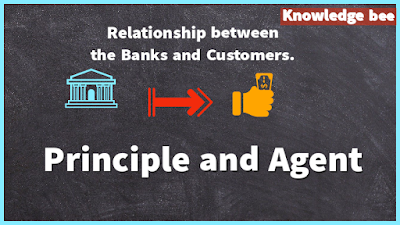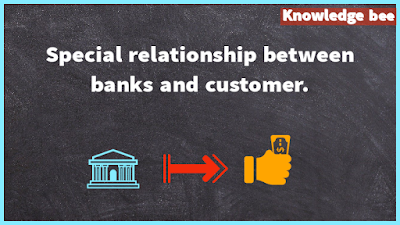In this post we are going to discuss about Relationship between the Bank and customer.
Q: What is a bank?
Ans: In Simple words , we can say that Bank is a financial institution that undertakes banking activities i.e. it accepts deposits and then lends them to make certain profits.
Q: who is a customer for bank?
Ans: A person who has an account with the bank is said to be a customer of the bank.
Relationship between the Bank and the Customer
A definite relationship exists between the banker and the consumer. Bankers and customers are like two sides of the coin, the success and survival of a business depends on mutual trust between these two parties. The relationship between the banker and the customer begins when an account is opened with the bank and ends immediately upon account closure. This relationship depends upon the nature of the service provided by the banker.
Debtor and creditor: The real relationship between a banker and a customer is that of a creditor and a debtor. When a person makes a deposit to open an account, the banker becomes a debtor and a customer becomes a creditor. But on the other hand, when a consumer avails an overdraft facility, the relationship between the debtor and the creditor is reversed i.e the banker becomes a creditor and the customer becomes his debtor. on opening an account, banker undertakes to accept money which is repayable on demand. The banker is entitled to use the deposited money. He is responsible for refund in accordance with the terms and conditions.
Trustee and Beneficiary: Usually, a banker is a debtor of his client in the report of the deposit made by the letter, but in some cases, he acts as a trustee also.
A trustee holds money or assets and performs certain functions in the name of the beneficiary for the benefit of another person.
For example: If a client deposits services or other values with a banker for safe and secure custody, the letter acts as a trustee of his customer.
3. Principle and Agent: A banker acts as his client’s agent and performs various agency duties for the convenience of his customer. For example, he buys or sells securities against his customer, collects cheques on his own, and makes payment of various dues of his client.
4. Mortagee and Mortagager: When a consumer effects a mortgage deed of his immovable property in favor of the bank or deposits the title deed of its property with the banker to secure the loan, the mortgage and Mortgager relationship is established between the customer and the banker. The banker becomes the mortgagee and the customer becomes the Mortgager .
5. Lassee and Lessor : The relationship between a banker as Lassee and his customer as lessor is established. When a customer keeps his valuables and articles in locker in a bank for safe and secure custody. The banker takes the necessary precautions to protect the goods placed in the locker.
6 . Banker as attorney: The customer can grant a special power of attorney to his banker to do certain transactions on his behalf .The banker is the attorney of the customer in such cases.
7. Other relations: The banker also acts with the merchant to advise the customer on financial matters and to help raise new capital. Bankers also act as guarantors by issuing letters of credit to the customer.
Special relationship between banks and customer.
Obligation of a banker : The provisions of Negotiable Instrument impose the following special obligations on the bank:
1. Obligations to honour customer’s cheque:The bank has an obligation to respect customer cheques whenever they are presented as long as there is sufficient amount of credit available in the customer’s account. According to banks basic contract ,is usually to repay the amount received for his customers’ accounts by honoring his cheques.
This obligations arises out implied situation between the parties:
Whenever the customer makes a written request to the branch where he maintains the current account, the banker should return the borrowed funds.
The banker should not damage the customer’s credit by dishonouring the cheques except on reasonable grounds.
Section 31 of the Negotiable Act ,1881,states that,”the drawee of a cheque having sufficient funds of the drawer in his hands, adequately applicable to the payment of such cheque, When the check needs to be paid properly, as such payment, any loss or damage caused by such default must be returned to the drawer. “Thus, a banker must honour the customer’s cheques drawn on him provided.
(a) Sufficient funds of the customer in his hand: The obligation of a bank to honour customer’s cheque arises when it has sufficient funds in the customer’s account, at least equal to or more than of cheque. If there is no proper balance, the bank is entitled to terminate its liability.
(b) Correctness of the cheque: The obligation to cheque depends upon the accuracy of the check. All required specials such as date, recipient’s name, word and figure, amount and signature of the drawer should have been filled correctly.
(c) Proper drawing of the cheque: The cheque will be honoured only if it is drawn in accordance with the requirements of the law. It should be prepared on a printed form provided by the bank and it should not contain any ‘request’ to pay the amount.
(d) Proper application of the funds : The bank will honor a cheque only if the funds are meant for its repayment, for example, if the trust funds are withdrawn by check for private use, the banker will not honour it.
(e) Proper Presentation: The bank will undertake to honor the cheques provided they are presented at the branch where the account is kept and during banking hours. If the checks are presented after six months from the date of issue, they will be treated as stale checks and will not be honoured.
(f) Reasonable time for collection: A customer cannot impose a condition on the bank to pay his checks blindly even if it is drawn against the cheques sent for collection before they are collected.
(g) Existence of Legal bar :A bank is free from its legal duty to honor its customer’s cheques If there is any legal restriction such as a garnishee order linking the user’s account.









